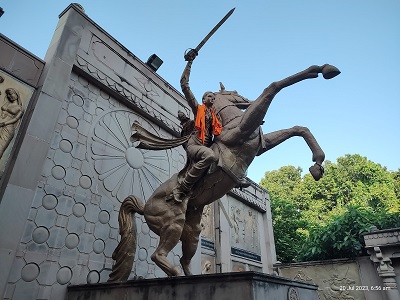Just imagine how the English, who were accustomed to seeing their women in corsets, would have been shocked to see a woman riding a horse with a sword and shield in hand. I’m talking about the epitome of bravery, Rani Lakshmibai of Jhansi, whose tales of valour have inspired us all. In today’s post, I’m paying homage to Rani Lakshmibai’s birthplace, her courage, and her sacrifice. If you, like me, draw inspiration from her bravery, let’s explore Rani Lakshmibai’s birthplace through this video and try to learn something from her life. You’re watching the Independence Day Special – Exploring the birthplace of the icon of bravery.
Location of The Birthplace of Rani Lakshmibai and its Surroundings
This part of Varanasi isn’t known for its ghats or temples. It’s not a place of worship, but for Indian patriots, it’s as sacred as any temple, as it holds the history of the 1857 uprising. This is the soil where a young woman of Indian history learned to walk her first steps. This is the birthplace of Rani Lakshmibai, located in the eighty-area region of Varanasi.
Early Life of the Queen of Jhansi
From her birth until the age of 3, Manikarnika Tambe, later known as Rani Lakshmibai, played and grew up around the ghats and streets of Varanasi. At an age when children usually attend play school, she was playing with toy swords, organizing armies, and making important decisions. A short distance away is Tulsi Ghat, where the great poet Tulsidas wrote the Ramcharitmanas.
A prominent Varanasi ghat, Manikarnika Ghat, was named after her, and her parents affectionately called her Manu. Her mother, Bhagirathi Sapre, passed away just two years after giving birth to Manu. A year later, Manu was brought to Bithoor by Peshwa Bajirao II, as her father Moropant Tambe was one of the chief generals of the Peshwa. Manu was often called Chhabili due to her lively nature.
What made Rani Lakshmibai gain such an impeccable personality?
Lakshmibai’s upbringing was different from that of an ordinary girl; she was raised like a warrior. Her upbringing wasn’t a singular event; many other women, like Jhalkari Bai, stood shoulder to shoulder with her in battles after she ascended the throne.
Having acquired skills in horse riding, swordsmanship, and warfare, Manu married King Gangadhar Rao of Jhansi. Her generous nature quickly endeared her to the people’s hearts.
Tragedy struck soon after, as her infant son passed away, followed by her husband’s demise. Taking advantage of the situation, the British denied recognition to her adopted son and asked Rani Lakshmibai to leave Jhansi. Defiantly, she said, “I will not leave Jhansi.” This single statement marked a turning point in India’s struggle for independence.
Despite facing numerically superior British forces, Rani Lakshmibai fought valiantly. She resisted British efforts and ultimately joined forces with Tatya Tope to capture the Gwalior Fort. Even after her demise, the British couldn’t capture the Gwalior Fort for two days.
And history was written
Her fight laid the foundation for India’s fight for freedom. Many were inspired by her and sacrificed their lives for the country. Before the battle, she had told her troops, “We will fight so that our future generations can celebrate freedom.” This year, as we celebrate the 76th Independence Day, I urge you to visit Jhansi’s birthplace of Rani Lakshmibai. Light a lamp of gratitude on her birth soil.
Why we must pay a visit to the birthplace of Rani Lakshmibai?
I hope the way Rani Lakshmibai’s life has inspired me has also impacted you. The purpose of this post was to pay tribute to Rani Lakshmibai on this sacred occasion of Independence Day and to raise awareness about her birthplace.
With this, today’s segment comes to an end. I extend my heartfelt Independence Day greetings to all my fellow Indians.


